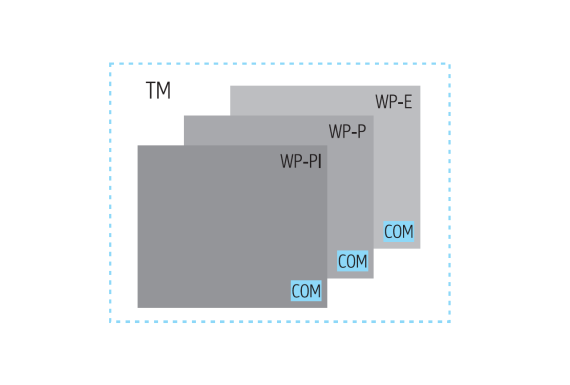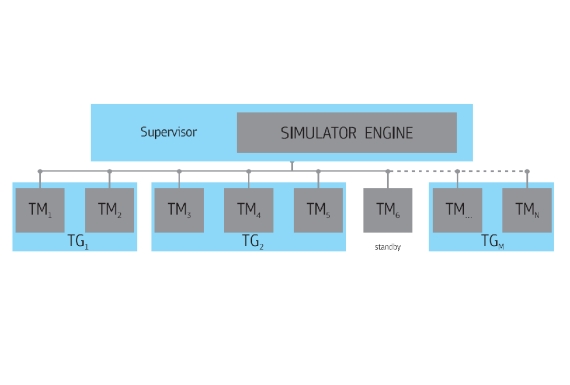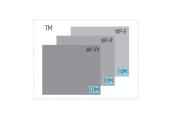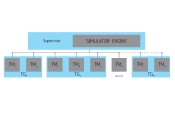ATC Simulator
- Home
- ATC systems
- ATC Simulator
Air Traffic Control (ATC) Simulator is designed for training, professional development, certification assessment of air traffic controllers as well as for research of air traffic management.
ATC Simulator supports all procedures and functions of air traffic controller workstations for Area Control Center (ACC), Approach (APP), Aerodrome Control Tower (TWR) as well as for Military Control Tower.
ATC Simulator may optionally include ATC Tower Simulator (Tower visualization equipment), More information about ATC Tower Simulator.
ATC Simulator consists of typical training modules (TM) used to create, conduct exercises and record in local mode.
Training module includes:
- Pilot-instructor working position (WP-PI);
- Flight Planning working position (WP-P)'
- Executive controller working position (WP-E).
Each working position is equiped with communication consoles for communication between controllers and pilots.
To conduct a complex training, the training modules can be combined into training groups (TG) and training complex (TC) from the supervisor working position (WP-SV).
ATC Simulator models air traffic in the area of responsibility defined by the user. The structure of modeled airspace contains description of static parameters:
- ATC sectors (ACC and/or APP);
- aerodromes;
- types of aircraft;
- holding areas;
- ATC points;
- ATC routes;
- parameters of SafetyNets;
- flight restriction areas, etc.
ATC Simulator also models:
- radars sensors;
- primary radars (PSR);
- secondary radars (SSR) including Mode S support;
- automatic direction finders (ADF);
- weather data;
- air traffic;
- "air-ground" communication.
FDP Server application runs on WP-PI, creates and supports flight data processing during exercise execution:
- configuration of the area of responsibility of ATC Center;
- generation of ATC equipment database;
- generation of aircraft database;
- configuration of ATC Simulator workstations;
- configuration of adjacent ATC units;
- generation of system parameters database;
- generation of exercise database;
- conducting exercises within database configuration;
- preparation of baseline data for air traffic modeling;
- entry of ATC Simulator configuration (sectorisation);
- preparation of weather data used for air traffic modeling;
- generation of aircraft types flight performance characteristics database;
- generation of ATC routes database;
- generation of preliminary (daily) flight plan and transmission of exercise data to the track generator;
- additional editing of ATC routes and trajectory parameters of simulated aircraft before exercise launch;
- entry of system parameters;
- simulation of APP Controller actions - auto-departure/auto-arrival;
- processing of flight plans during exercise (ATC Simulator server function).
"Track and Exercise" generator is implemented on WP-PI and includes:
- modeling of reference trajectories based on FDP initial data;
- modeling of weather and events based on FDP initial data;
- correction of aircraft movement trajectories based o instructions from pilots.
MRT Server application runs on WP-PI and implements:
- modeling of probabilistic detection reference aircraft by radar sensors;
- generation of mono-radar and multi-radar tracks based on data from radar sensors;
- correlation of flight data with surveillance information;
- indication of STCA, MSAW, APW.
Voice Recording server can be installed as a separate unit. Voice Recording server provides:
- configuration of TM and T communication equipment;
- voice communication between TM and TG pilots and controllers;
- recording of voice communication.
Recording Server is implemented on WP-SV and provides recording of:
- pilot and controller interface;
- events;
- LAN exchange data;
- playback of recorded voice and data.
WP-SV:
- creation and configuration of TM and TG;
- storing all created configuration of TM and TG, storing exercise database;
- application of selected configuration of TM and TG;
- time synchronization of simulator equipment.
WP-PI:
Exercise preparation:
- creation of aircraft flights plans;
- description of weather events;
- description of general events;
- storing exercises;
- editing existing exercises.
Exercise performance:
- adjustment of exercise parameters (simulation of departure/arrival, OLDI);
- time entry, exercise Start;
- manual flight control on controller's instruction (deviation from the flight plan);
- voice communication between pilots and controllers;
- voice interaction with controllers from adjacent ATC units.
WP-E, WP-P:
- presentation of air traffic (tracks/plots) on the map background);
- displaying SFPL, sector planning;
- automatic and manual aircraft handover;
- en-route, on departure and arrival flight planning;
- indication of Safety Nets and MONA procedure, MTCD;
- equipment and process management;
- displaying weather, aeronautical and reference information;
- CPDLC support.
Voice Communication System
All work stations are equipped with communication console providing:
- radio communication between pilots and controllers, aircraft bearing mapping;
- radio communication between pilots;
- controller communication with adjacent ATC units;
- communication between pilots;
- recording of all communications.
Administration
When in instructor mode any WP-PI working position provides:
- description of FIR areas responsibility and control sectors;
- entry of maps;
- configuration of ATC parameters.



